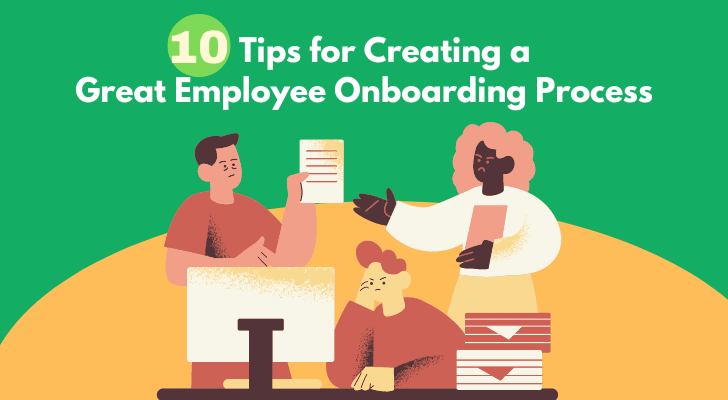Hiring the perfect candidate involves much more than sticking a job advert online and waiting for someone to bite; you need to have an onboarding strategy. Having this in place will ensure every new member of the team feels welcome and valued, which will encourage them to stay and prevent you from having to start the process all over again. Throughout this article, we’ll tell you what makes a great employee onboarding process.

#1 Pre-Start Contact
The onboarding process needs to begin before a new employee's first day. Make sure that you’ve made contact to hand over the necessary paperwork and ensure they know exactly how their first day will go. During this time, you can send them the employee handbook so that they can get to grips with the company further.
A good employee handbook is a comprehensive guide that outlines the company's policies, procedures, and expectations for employees. It should cover important topics such as:
- Company mission, vision, and values
- Employment policies and procedures, including hiring, onboarding, and termination
- Code of conduct, including expected behavior, dress code, and use of company property
- Benefits and compensation information, including vacation, sick leave, and health insurance
- Safety and security procedures, including emergency response plans
- Discrimination and harassment policies, including reporting procedures
- Technology policies, including acceptable use of company equipment and information security measures
- Performance management policies, including employee evaluations and promotions
- Training and development opportunities for employees
- Legal compliance information, including labor laws and regulations.
A good employee handbook should be written in clear and concise language, and should be easily accessible to all employees. It should be regularly updated to reflect changes in policies and procedures, and should be reviewed by legal counsel to ensure compliance with all relevant laws and regulations.
#2 Management Outreach
Management outreach is where managers and executives proactively reach out to employees (or customers, suppliers, etc.) to maintain positive relationships. The goal of management outreach with employees is to build trust, foster open communication, and gather feedback on the company's operations.
You should make efforts to have their manager make contact, as this will give them a chance to ask any role-specific questions. Additionally, by allowing this type of contact, you may reduce some of the nerves your new employee will likely be feeling.
Effective management outreach requires strong communication skills, the ability to build rapport with diverse groups of people, and a willingness to listen and act on feedback. It can help improve employee morale, build loyalty, and ultimately drive business success.
#3 Prepare All Tools and Resources
You need to make sure that your new employee has everything they need to get straight to work, which means ensuring they have all the resources available. Consider everything they could possibly need to complete their job, including digital tools, and ensure they know where to find it.
Some of the most common tools and resources provided by companies include:
Computer hardware and software: This includes desktops, laptops, tablets, and smartphones, as well as productivity software such as Microsoft Office and collaboration tools like Slack and Zoom.
Training and development programs: Companies may offer training and development programs to help employees acquire new skills and advance in their careers. This can include classroom training, online courses, mentoring programs, and job shadowing opportunities.
Health and wellness programs: Companies may offer health and wellness programs to encourage employees to maintain healthy habits and reduce stress. This can include gym memberships, nutrition counseling, mental health resources, and wellness challenges.
Benefits and compensation: Companies typically offer a range of benefits and compensation packages to attract and retain employees. This can include health insurance, retirement plans, paid time off, and bonuses.
Performance management tools: Companies may use performance management tools to track employee progress, set goals, and provide feedback on performance. This can include software programs like Salesforce, customer relationship management (CRM) systems, and project management tools.
Employee assistance programs (EAPs): EAPs offer employees confidential access to counseling and other support services for personal or work-related issues.
Safety and security resources: Companies may provide safety and security resources to protect employees and prevent workplace accidents. This can include safety training, emergency response plans, and security systems.
#4 Arrange a Team Greeting Meeting
No matter what industry you work in, whether it be in-person or remote, it is essential to schedule a team greeting meeting, which will allow your new hire to integrate with the team. During the meeting, be sure to throw in some fun icebreakers, as this will help to remove barriers and promote comfort.

Here are some team greeting meeting ideas:
Introductions:
Start by introducing all team members, including the new ones. Allow everyone to share a bit about themselves, including their role on the team, their background, and any other fun facts they want to share.
Icebreakers:
Consider playing a team-building game or icebreaker to help everyone get to know each other better. This can be a great way to break the ice and create a more relaxed atmosphere.
Team goals:
Take some time to discuss the team's goals and objectives. This can help new team members understand what the team is working towards and how they can contribute.
Feedback:
Encourage team members to share feedback and ideas for how the team can work together more effectively. This can help foster a culture of open communication and continuous improvement.
#5 Provide a Buddy/Mentor
Slotting into an existing team is challenging, and managers won’t always have the time to answer questions. Therefore, you should assign your new team members with a buddy to show them the ropes and answer any questions. As well as answering questions, their buddy will lead by example and show them how life in the business works.
You can provide incentives to the buddies/mentors to reward their performance and motivate them to continue to excel in their roles, such as;
- Bonuses: Companies may offer bonuses to those mentors who meet or exceed their goals, or who demonstrate exceptional leadership and teamwork.
- Promotions: The buddies who perform well may be eligible for promotions within the company. This can be a great incentive to encourage them to continue to improve and take on additional responsibilities.
- Professional development: Companies may offer the mentors opportunities for professional development, such as attending conferences or taking courses. This can help team leaders acquire new skills and knowledge, which can benefit both themselves and the new employees.
- Recognition: Simple recognition can also be a powerful incentive for them. This can include public recognition in company meetings or newsletters, or even a simple thank-you note or email from their supervisor.
- Flexible work arrangements: Companies may offer them more flexible work arrangements, such as the ability to work from home or adjust their work schedule.
Incentives can be an effective way to motivate team leaders and show appreciation for their hard work and dedication. The specific incentives offered may vary depending on the company and the needs of the team, but the goal is always to encourage high performance and create a positive work environment.
#6 Sufficient Training Provisions
If you throw your new employee into the deep end without allowing them time to learn how everything works, they’ll end up leaving before their probation period ends. Therefore, make sure you have a proper training programme in place, which will allow them to learn new processes and adopt any business-relevant terminology. After they have learned the basics, you can steadily increase their workload and responsibilities.
#7 Setting Clear Expectations
The onboarding procedure is all about setting people up for success within your company, so you need to have a clear view of what that looks like and a way to measure it. Setting clear expectations and goals is a great start. However, you need to make sure that goals are achievable and measurable, so always use the SMART goal concept.
#8 Monitoring Progress
Setting goals and pairing your new hire with a buddy is a great start, but you will need to check in regularly to make sure they are settling in well, answer questions, and discuss/update goals. During the probation period, it is important to begin employee appraisals, which will be an ongoing feature of their employment.

#9 Make it Interesting
You will find countless templates for putting together an onboarding process, but you need to put your own spin on it and make it interesting to keep their attention. For example, you can turn the onboarding process into an engaging experience by running an incentive programme. This can be anything from bonus pay to additional holidays, providing they reach certain KPIs. Alternatively, you can make the training material interactive so that employees aren’t just reading from a textbook; the ideas are endless.
Here are some ways to make training material interactive to improve engagement and retention;
- Use multimedia: Incorporate different types of multimedia, such as videos, images, and animations, to make the training material more visually appealing and engaging.
- Gamify the content: Create games or quizzes that incorporate the training material, such as a Jeopardy-style game or a multiple-choice quiz, to make the learning process more fun and interactive.
- Use scenarios and case studies: Use real-world scenarios and case studies to help employees apply the training material to real-life situations and encourage critical thinking.
- Group activities: Incorporate group activities and discussions, such as role-playing exercises or brainstorming sessions, to encourage collaboration and participation.
- Interactive simulations: Use interactive simulations to help employees practice applying the training material in a safe and controlled environment.
- Interactive assessments: Use interactive assessments, such as drag and drop exercises or interactive diagrams, to test employees' knowledge and understanding of the training material.
- Personalize the content: Personalize the training material by incorporating employees' interests and experiences, such as examples that relate to their job role or industry.
By using a combination of these techniques, companies can create training material that is not only informative but also engaging, interactive, and memorable.
#10 Think Future
When employees start at your company, they want to know that a bright future is within reach, so tell them what that looks like from day one. Lay out a clear roadmap when they start and take them on a journey by telling them about how to progress. To make this feel less hollow, be sure to provide tangible evidence in the way of stories from existing employees.
Companies without an onboarding policy in place see high turnover levels, so set up your business for success by making sure new team members feel welcomed and prepared. Guide them through the first 90 days of employment but avoid holding their hand - they need room to grow.
What Do You Advocate?
Here are some steps that employers can take to help new employees during this period:
Provide a clear onboarding plan: Create a structured onboarding plan that outlines the new employee's key milestones, goals, and expectations for the first 90 days. This plan should be shared with the new employee during their first week on the job and reviewed regularly to ensure they are on track.
Set up regular check-ins: Schedule regular check-ins with the new employee to review their progress, answer any questions they may have, and provide feedback and support. These check-ins can be weekly or bi-weekly and can be conducted in-person, over the phone, or via video conferencing.
Assign a mentor or buddy: As mentioned above, assign a mentor or buddy to the new employee to provide additional support and guidance during their first 90 days. This person should be someone who is familiar with the company culture, policies, and procedures, and who can help the new employee navigate any challenges they may face.
Provide training and development opportunities: Offer training and development opportunities that align with the new employee's job responsibilities and career goals. This can include online courses, on-the-job training, mentorship programs, and more.
Introduce the new employee to the team: Introduce the new employee to their team members and other key stakeholders within the organization. This can include setting up one-on-one meetings, team lunches, or virtual introductions.
Provide regular feedback: Provide regular feedback to the new employee on their performance, highlighting areas of success and areas for improvement. This feedback should be constructive and specific, and should be delivered in a timely manner.
By taking these steps, employers can help new employees feel supported, engaged, and motivated during their first 90 days on the job, setting them up for long-term success within the organization.
